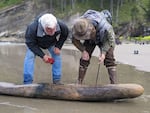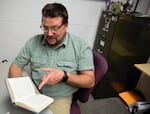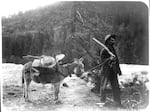The Oregon coast was buzzing recently with news of the possible discovery of the Spanish galleon that inspired the plot of “The Goonies.”
But in truth, Oregon’s coast is home to many legends of lost treasure. Talk to the right people in just about any community along the Pacific Ocean, and you’ll eventually find a tale of fortunes won, lost … or buried for some lucky soul to stumble across.

Marine archaeologist James Delgado, left, and beachcomber Craig Andes, right, examine a shipwreck timber removed from the sea caves north of Manzanita that may be from the long-ago famous wreck of a Spanish galleon that inspired the plot of the cult classic, "The Goonies."
Katie Frankowicz / KMUN
“I’ve been kind of on a roll of buried treasure, lost gold mine stories and stuff like that,” said pop historian Finn J.D. John, an instructor at Oregon State University’s School of Communication.
Recently, John has been researching the Randolph Trail gold cache, which was supposedly hidden 170 years ago by the Grouleaux brothers or maybe the Groslius brothers; different sources have different spellings.
Whatever their name, they lived in the Willamette Valley, and back in 1849, they headed south for California.
“People in Oregon got a real head start on the gold rush when it broke out,” John said. “They got there long before everyone else got around the horn to show up and start digging. So they got a big jump.”
But instead of leaving the state by way of the Willamette Valley to make their fortune, like other Oregonians with dreams of gold on their way to California, the brothers made their way along the coast.
“This was a terrible idea of course, for geological reasons, if nothing else because of all the rivers they’d have to figure out how to get across,” John said.
But their choice proved fortuitous, because when the brothers reached the beaches south of Coos Bay, they saw a glistening sheen of gold in the sand – at least, that’s what the stories tell us.

Pop historian Finn J.D. John has been looking into the legend of the Randolph Trail gold cache.
Kristian Foden-Vencil / OPB
“It was black, and it had sparkles in it,” John said. " And on a lark, they dipped some out with a gold pan and sluiced it around and discovered that there was indeed gold on the beach.”
The brothers probably would have tested what they found, to make sure it wasn’t fools gold, also known as iron pyrite. It turned out, they’d found the real thing.
“There’s nobody around. Everybody in the area has gone inland to go south for the gold fields,” John said. “And there they are with this massive bonanza just crunching under their feet. So of course, they got busy.”
The brothers had brought plenty of provisions, and the hunting was good, so they prospected all summer. As their flour sacks emptied, they refilled the bags with gold. For three years they returned, unbeknownst to anyone.
“You would think that people would think: ‘Oh, these guys are onto something.’ But of course, a lot of people who were going south were hitting pay dirt, so it was easier to fly under the radar,” John said.

A prospector on the trail with a burro in Grants Pass, Ore., 1903.
Library of Congress
Miners were a secretive bunch by nature. Claim jumping was a real threat back then, as were bandits. But by their fourth year, the brothers’ secret was out and miners flocked to Southern Oregon.
Boom towns like Randolph sprouted almost overnight.
In the 1957 book “Lost Mines and Treasures of the Pacific Northwest,” author Ruby El Hult describes the scene: “...a thousand men milled about on the black sands, staking claims for miles up and down the beach. Cabins, stores, saloons and gambling houses were hastily erected, becoming the boom town of Randolph.”
She wrote that whiskey flowed so freely, the stream along which the best diggings were located became known as Whiskey Run.
Already rich, the Grouleaux brothers decided to sell their claim for $40,000, the equivalent of about $1.5 million today. They also decided not to hang around.
Still, they faced one big problem. They were laden with gold, and there was only one path out of town – today it’s known as Seven Devils Road – and they worried about being robbed. As John tells it, the story goes that they found a distinctive-looking cedar tree and stashed two gunpowder cans full of gold, $40,000 worth, beneath it.
The brothers got home safely and presumably enjoyed living on the money they’d found during their first three years mining in Oregon. They traveled to Europe. One died in England, the other didn’t return to look for the gold for 20 years.
“I don’t know how one burns through a stash like that,” John said. “But some people have superpowers. So he wanted his stash, $40,000 and he couldn’t find it.”
Trees grow fast on the Oregon coast. Stumps rot, wildfires burn and forests get logged. The spot where the brothers buried their gold was unrecognizable when one returned. Fifty years later one of their granddaughters came to find it, but also failed.
Now the story of the lost Randolph Trail cache is just one of many buried treasure stories people tell on the coast.
“That’s a new one,” said Meryl Boice, the former president of the Curry County Historical Society in Gold Beach, “I never heard of it.”

Author Meryl Boice with her book "Gold Beach and South Curry County." She's chronicled many tales of lost coastal treasure.
Kristian Foden-Vencil / OPB
For years, Boice collected similar tales and published them in the society’s newsletter.
Like the one from old miner Tommy East. He told of a Native American man, dying of pneumonia, being nursed by a kindly couple.
“He had some gold, and he put in his pants and tied the legs and stuck it in a hollow tree and put leaves on it. And told this couple where it was, when he knew he was not going to make it,” Boice said. “They went out, after he passed away and looked and nobody ever found it.”
So somewhere on the coast, there’s $35,000 worth of 1850s gold stashed in a pair of buckskin breeches. Maybe...
Historians tell of another story about a Spanish galleon that lay anchor in Nehalem Bay some time in the 1600s. Crew members are said to have come ashore to bury a chest of treasure on Neahkahnie Mountain.
The thing is, there’s little if any original documentation for such stories, so it’s hard to know what’s true and what’s been fabricated or embellished. Still, John is relatively confident about the Randolph Trail cache legend.
“I think there’s a zero percent chance that every single particular is true,” he said. “And I think that there’s a 100% chance that most of it is true.”
But before buying a metal detector and heading to the coast, it’s good to remember that taking something off someone else’s land is illegal, even if they don’t know it’s there.
Also in the 1930s, there was a rumor that the cans had been found by an unidentified couple. Apparently, they’d seen a rusty gun barrel sticking out from under an old tree stump. So they dug around and found two old gunpowder cans containing 150 pounds of gold.
But John thinks that stash is probably attributable to an old miser, known for burying his money in the area. John points out the amount of gold doesn’t match the Randolph Trail cache and the cans would have rusted away after 80 years in the coastal climate.
“There would have been nothing left,” he said. “There wouldn’t have been cans, there would have just been a bunch of gold in the ground.”
Meanwhile, the black sands of Oregon’s beaches still contain some gold. But using powered machinery on the beach is illegal, and without mechanized help, you’d be hard pressed to make minimum wage, let alone a fortune.


